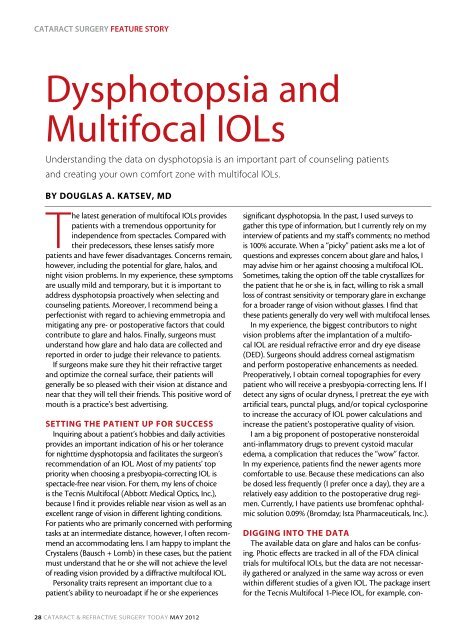Dysphotopsia and Multifocal IOLs - Sansum Clinic
Dysphotopsia and Multifocal IOLs - Sansum Clinic
Dysphotopsia and Multifocal IOLs - Sansum Clinic
You also want an ePaper? Increase the reach of your titles
YUMPU automatically turns print PDFs into web optimized ePapers that Google loves.
Cataract Surgery Feature story<br />
<strong>Dysphotopsia</strong> <strong>and</strong><br />
<strong>Multifocal</strong> <strong>IOLs</strong><br />
Underst<strong>and</strong>ing the data on dysphotopsia is an important part of counseling patients<br />
<strong>and</strong> creating your own comfort zone with multifocal <strong>IOLs</strong>.<br />
By Douglas A. Katsev, MD<br />
The latest generation of multifocal <strong>IOLs</strong> provides<br />
patients with a tremendous opportunity for<br />
independence from spectacles. Compared with<br />
their predecessors, these lenses satisfy more<br />
patients <strong>and</strong> have fewer disadvantages. Concerns remain,<br />
however, including the potential for glare, halos, <strong>and</strong><br />
night vision problems. In my experience, these symptoms<br />
are usually mild <strong>and</strong> temporary, but it is important to<br />
address dysphotopsia proactively when selecting <strong>and</strong><br />
counseling patients. Moreover, I recommend being a<br />
perfectionist with regard to achieving emmetropia <strong>and</strong><br />
mitigating any pre- or postoperative factors that could<br />
contribute to glare <strong>and</strong> halos. Finally, surgeons must<br />
underst<strong>and</strong> how glare <strong>and</strong> halo data are collected <strong>and</strong><br />
reported in order to judge their relevance to patients.<br />
If surgeons make sure they hit their refractive target<br />
<strong>and</strong> optimize the corneal surface, their patients will<br />
generally be so pleased with their vision at distance <strong>and</strong><br />
near that they will tell their friends. This positive word of<br />
mouth is a practice’s best advertising.<br />
SETTING THE PATIENT UP FOR SUCCESS<br />
Inquiring about a patient’s hobbies <strong>and</strong> daily activities<br />
provides an important indication of his or her tolerance<br />
for nighttime dysphotopsia <strong>and</strong> facilitates the surgeon’s<br />
recommendation of an IOL. Most of my patients’ top<br />
priority when choosing a presbyopia-correcting IOL is<br />
spectacle-free near vision. For them, my lens of choice<br />
is the Tecnis <strong>Multifocal</strong> (Abbott Medical Optics, Inc.),<br />
because I find it provides reliable near vision as well as an<br />
excellent range of vision in different lighting conditions.<br />
For patients who are primarily concerned with performing<br />
tasks at an intermediate distance, however, I often recommend<br />
an accommodating lens. I am happy to implant the<br />
Crystalens (Bausch + Lomb) in these cases, but the patient<br />
must underst<strong>and</strong> that he or she will not achieve the level<br />
of reading vision provided by a diffractive multifocal IOL.<br />
Personality traits represent an important clue to a<br />
patient’s ability to neuroadapt if he or she experiences<br />
significant dysphotopsia. In the past, I used surveys to<br />
gather this type of information, but I currently rely on my<br />
interview of patients <strong>and</strong> my staff’s comments; no method<br />
is 100% accurate. When a “picky” patient asks me a lot of<br />
questions <strong>and</strong> expresses concern about glare <strong>and</strong> halos, I<br />
may advise him or her against choosing a multifocal IOL.<br />
Sometimes, taking the option off the table crystallizes for<br />
the patient that he or she is, in fact, willing to risk a small<br />
loss of contrast sensitivity or temporary glare in exchange<br />
for a broader range of vision without glasses. I find that<br />
these patients generally do very well with multifocal lenses.<br />
In my experience, the biggest contributors to night<br />
vision problems after the implantation of a multifocal<br />
IOL are residual refractive error <strong>and</strong> dry eye disease<br />
(DED). Surgeons should address corneal astigmatism<br />
<strong>and</strong> perform postoperative enhancements as needed.<br />
Preoperatively, I obtain corneal topographies for every<br />
patient who will receive a presbyopia-correcting lens. If I<br />
detect any signs of ocular dryness, I pretreat the eye with<br />
artificial tears, punctal plugs, <strong>and</strong>/or topical cyclosporine<br />
to increase the accuracy of IOL power calculations <strong>and</strong><br />
increase the patient’s postoperative quality of vision.<br />
I am a big proponent of postoperative nonsteroidal<br />
anti-inflammatory drugs to prevent cystoid macular<br />
edema, a complication that reduces the “wow” factor.<br />
In my experience, patients find the newer agents more<br />
comfortable to use. Because these medications can also<br />
be dosed less frequently (I prefer once a day), they are a<br />
relatively easy addition to the postoperative drug regimen.<br />
Currently, I have patients use bromfenac ophthalmic<br />
solution 0.09% (Bromday; Ista Pharmaceuticals, Inc.).<br />
DIGGING INTO THE DATA<br />
The available data on glare <strong>and</strong> halos can be confusing.<br />
Photic effects are tracked in all of the FDA clinical<br />
trials for multifocal <strong>IOLs</strong>, but the data are not necessarily<br />
gathered or analyzed in the same way across or even<br />
within different studies of a given IOL. The package insert<br />
for the Tecnis <strong>Multifocal</strong> 1-Piece IOL, for example, con-<br />
28 Cataract & Refractive Surgery Today May 2012
Further Considerations in the Selection of a <strong>Multifocal</strong> IOL<br />
By Michael E. Snyder, MD<br />
The surgeon has determined that a patient has an acceptably good<br />
prognosis for a multifocal IOL, including an adequately healthy cornea,<br />
macula, <strong>and</strong> optic nerve. The patient has decided that he or she<br />
desires a multifocal lens. A few additional considerations remain in the<br />
selection of an IOL.<br />
BODY HABITUS<br />
The focal length of multifocal lenses differs. Among the diffractive<br />
models, the Tecnis <strong>Multifocal</strong> IOL (ZMAOO <strong>and</strong> ZMBOO; Abbott<br />
Medical Optics Inc.) has an add power of +4.00 D. This may be a suitable<br />
<strong>and</strong> even desirable reading distance for a diminutive patient with<br />
short arms. A tall patient with long arms, however, can find this working<br />
distance uncomfortably close <strong>and</strong> will likely do better with a +3.00<br />
D add, as is found with the AcrySof IQ Restor IOL +3.0 D (SN6AD1,<br />
MN6AD1; Alcon Laboratories, Inc.).<br />
DAILY ACTIVITIES<br />
Some presbyopic patients perform many intermediate-range tasks<br />
such as the use of computers <strong>and</strong> tablets, knitting, <strong>and</strong> cooking. These<br />
individuals are well suited to multifocal lenses with a +3.00 D add; the<br />
near point will be closer to their midrange, <strong>and</strong> thus, the summation<br />
that occurs between the two focal points will be higher <strong>and</strong>, consequently,<br />
superior for intermediate tasks than an IOL with a +4.00 D<br />
add. Some surgeons advocate using multifocal <strong>IOLs</strong> with a +4.00 D<br />
add for these patients <strong>and</strong> targeting slight hyperopia to compensate<br />
for an undesirably close near point. I strongly discourage this approach<br />
<strong>and</strong> find that patients are happiest with a plano distance result<br />
ENVIRONMENTAL ILLUMINATION<br />
The diffractive steps of the Tecnis <strong>Multifocal</strong> IOL appear from its<br />
center to its periphery, <strong>and</strong> the steps are of equal height at all loci on<br />
the implant. This design distributes more light to the near add relative<br />
to the distance focal point compared with an apodized lens like the<br />
AcrySof Restor. The latter’s diffractive steps decrease in height from<br />
the center outward, <strong>and</strong> they are confined to the central 3.7 mm<br />
of the IOL’s optic. Accordingly, many surgeons feel that, as a group,<br />
patients who receive the Tecnis <strong>Multifocal</strong> lens perform better at<br />
near in dimly lit situations (eg, the c<strong>and</strong>lelit restaurant to which Dr.<br />
Katsev alludes) than patients with the AcrySof Restor lens. For the<br />
same reason, patients with the Tecnis <strong>Multifocal</strong> may also tend to<br />
notice more halos at night around point sources of light against a<br />
dark background (eg, streetlights at night) than individuals with the<br />
AcrySof Restor.<br />
PUPILLARY SIZE<br />
The refractive ReZoom IOL (Abbot Medical Optics Inc.) has a large<br />
central zone that is distance only. I have seen some patients who have<br />
no near or intermediate benefit with this lens when their pupil is at<br />
rest but who perform well at near when it is pharmacologically dilated.<br />
Obviously, this is an untenable <strong>and</strong> unhappy result for both the<br />
patient <strong>and</strong> the physician. My colleagues <strong>and</strong> I rarely use the ReZoom<br />
in our practice, because we have found that diffractive multifocal <strong>IOLs</strong><br />
perform better.<br />
Interestingly, the initial<br />
FDA data on the ReZoom<br />
demonstrated a similar incidence<br />
of halos, by percentages,<br />
as for the diffractive<br />
multifocal <strong>IOLs</strong>, yet in my<br />
experience, the vehemence<br />
of the patients’ complaints<br />
about this phenomenon<br />
was unmistakably greater<br />
with the refractive lens.<br />
Studies of the clinical<br />
incidence of glare with<br />
multifocal lenses are difficult<br />
to interpret, due to<br />
highly inconsistent rates<br />
of implantation among<br />
the different multifocal<br />
lenses. Knowing the rates<br />
of unhappy patients with<br />
these <strong>IOLs</strong> in a referral<br />
practice is only useful if one<br />
also knows the differing<br />
frequency of implantation<br />
for each style of lens in that<br />
community.<br />
Figure. A three-piece PCIOL in this<br />
megalo-anterior segment is centered<br />
with the haptics in the ciliary sulcus <strong>and</strong><br />
the optic prolapsed through both the<br />
continuous curvilinear capsulorhexis <strong>and</strong><br />
a primary posterior continuous curvilinear<br />
capsulorhexis. The fixation elements<br />
of a Cionni Ring for Sclera Fixation <strong>and</strong><br />
two Ahmed Capsular Tension Segments<br />
(both devices from Morcher GmbH,<br />
distributed in the United States by FCI<br />
Ophthalmics, Inc.) are visible, oriented<br />
with each 120º apart. The patient sees<br />
20/20 uncorrected at distance <strong>and</strong> J1+<br />
at near.<br />
LOCATION OF THE IOL<br />
If fixation in the sulcus becomes necessary, the available three-piece<br />
multifocal <strong>IOLs</strong> perform similarly to surgeons’ expectations, especially<br />
if their optics can be captured in the capsulorhexis <strong>and</strong> the capsule<br />
covers the margin of the IOL’s anterior edge (Figure). Surgeons should<br />
avoid implanting single-piece PC<strong>IOLs</strong> in the sulcus, because this<br />
placement increases the risk of pigment dispersion or a condition<br />
resembling uveitis, glaucoma, hyphema syndrome. 1 For passive sulcus<br />
fixation in which capture with the capsulorhexis is not possible, a<br />
round-edged PCIOL is a better choice, <strong>and</strong> of course, the IOL’s power<br />
will need to be reduced relative to that calculated for the lens’ placement<br />
in the bag.<br />
CONCLUSION<br />
<strong>Multifocal</strong> <strong>IOLs</strong> are a wonderful option for presbyopic patients<br />
who desire increased independence from spectacles. Surgeons should<br />
carefully weigh each option on a patient-by-patient basis in order to<br />
recommend the IOL most likely to suit his or her desires, lifestyle, <strong>and</strong><br />
ocular anatomy.<br />
Michael E. Snyder, MD, is in private practice at the<br />
Cincinnati Eye Institute <strong>and</strong> is a voluntary assistant professor<br />
of ophthalmology at the University of Cincinnati. He is a consultant<br />
to Alcon Laboratories, Inc. Dr. Snyder may be reached<br />
at (513) 984-5133; msnyder@cincinnatieye.com.<br />
1. Kohnen T, Kook D. Solving intraocular lens-related pigment dispersion syndrome with repositioning of primary sulcus implanted singlepiece<br />
IOL in the capsular bag. J Cataract Refract Surg. 2009;35(8):1459-1463.<br />
May 2012 Cataract & Refractive Surgery Today 29
Cataract Surgery Feature story<br />
tains some surprising statistics. Thirty-seven percent of<br />
the multifocal group had moderate difficulty with halos,<br />
<strong>and</strong> 18% had severe difficulty at 1 year. Elsewhere in the<br />
same document, however, rates of 6% (moderate halos)<br />
<strong>and</strong> 5% (severe halos) are given. 1 The latter numbers are<br />
more in line with my personal experience, but why are<br />
there two different reports? Minor changes in the way a<br />
question is posed can make results look very different.<br />
As with any survey, it is easy to bias the responses,<br />
intentionally or not, through the phrasing of the question.<br />
When investigators asked a broad question (are you having<br />
any difficulties with your eyes or vision?), relatively few<br />
patients mentioned more than mild difficulty with glare,<br />
halos, or nighttime vision. In a third-party telephone survey<br />
that directly questioned patients about each symptom<br />
(how much difficulty do you have with halos at night?),<br />
the number of them reporting the problem was much<br />
higher. Curiously, the patients with monofocal lenses in the<br />
directed-question survey also reported high rates of photic<br />
phenomena, with 28% reporting moderate to severe difficulty<br />
with glare <strong>and</strong> 20% reporting moderate to severe<br />
difficulty with halos. 1 Those rates do not match my experience<br />
at all. Plus, patients’ overall satisfaction in the FDA trial<br />
was very high, with 92% saying they would choose a Tecnis<br />
<strong>Multifocal</strong> lens again. 1 That finding, plus the high rate of<br />
difficulty in the monofocal group, tells me that “directed”<br />
responses may not accurately represent results.<br />
In my practice, about 5% to 10% of patients who receive<br />
multifocal <strong>IOLs</strong> experience enough glare <strong>and</strong> halos to complain<br />
about them during the early postoperative period.<br />
After 1 year, however, those complaints largely disappear.<br />
In terms of the nondirected responses in the Tecnis’<br />
package insert, the proportion of patients with severe<br />
photic phenomena (glare, starbursts, or halos) is 12% 4 to<br />
6 months after the implantation of the Tecnis <strong>Multifocal</strong><br />
IOL <strong>and</strong> 7% at 1 year. These statistics more closely match<br />
my clinical experience <strong>and</strong> are comparable to, or in some<br />
cases better than, what has been reported for other multifocal<br />
<strong>IOLs</strong>. 2<br />
Considering REAL-WORLD SYMPTOMS<br />
In addition to developing a good underst<strong>and</strong>ing of<br />
clinical trial data, ophthalmologists should consider postapproval<br />
data, which better reflect how <strong>IOLs</strong> perform in<br />
the real world. The incidence of glare <strong>and</strong> halos is typically<br />
higher in FDA clinical trials, because participating surgeons<br />
may not be permitted to perform limbal relaxing incisions<br />
or enhancements or to make nomogram adjustments.<br />
DED also may not be addressed consistently.<br />
In a recently published review of 76 eyes of 49 patients<br />
who were dissatisfied after receiving multifocal <strong>IOLs</strong>,<br />
photic phenomena were reported for 29 eyes (38.2%). 3<br />
The Smiley Face Strategy<br />
Patients’ postoperative visual acuity is usually a strong<br />
indicator of their satisfaction. Sometimes, however, their<br />
level of satisfaction does not correlate with their UCVA,<br />
<strong>and</strong> the last thing you want to do is to congratulate an<br />
angry patient on his or her “great” vision. Avoid this gaffe<br />
by asking your staff to highlight anomalies for you. In my<br />
practice, we use a simple sticker system:<br />
• A smiley face means the patient may see 20/30, but<br />
he or she is thrilled.<br />
• A sad face tells me the patient is unhappy despite a<br />
20/20 <strong>and</strong> J1 result.<br />
• No sticker means my staff thinks the patient’s satisfaction<br />
level is about where I would expect given the<br />
visual result.<br />
This sticker system gives me a valuable heads-up for<br />
the tone I take during my examination.<br />
The majority of these patients, referred to a tertiary<br />
care center, had received the AcrySof IQ Restor IOL<br />
+4.0 D (Alcon Laboratories, Inc.; 69 eyes), but others<br />
had a ReZoom IOL (Abbott Medical Optics, Inc.; one<br />
eye), Tecnis <strong>Multifocal</strong> lens (two eyes), or an AcrySof<br />
IQ Restor IOL +3.0 D lens (Alcon Laboratories, Inc.;<br />
four eyes). Most important is that almost all of the eyes<br />
had correctible factors beyond the multifocal design<br />
itself that might have contributed to the glare or halos.<br />
They included residual refractive error (35%), wavefront<br />
anomalies (21%), decentration of the IOL (17%), posterior<br />
capsular opacification (10%), <strong>and</strong> DED (4%). The<br />
investigators found that most causes of patients’ dissatisfaction<br />
with multifocal <strong>IOLs</strong> can be treated successfully.<br />
The aforementioned researchers’ conclusion resonates<br />
with my own experience. By carefully selecting patients <strong>and</strong><br />
using thoughtful surgical protocols, surgeons can minimize<br />
the incidence of dysphotopsia. Furthermore, effective<br />
counseling can help patients to prepare for potential night<br />
vision problems <strong>and</strong> to underst<strong>and</strong> that these symptoms<br />
improve greatly within the first year. Overall, the value of<br />
multifocality for patients far exceeds the short-term dysphotopsia<br />
that a few experience with multifocal <strong>IOLs</strong>. n<br />
Douglas A. Katsev, MD, is in private practice at<br />
the <strong>Sansum</strong> Santa Barbara Medical Foundation<br />
in California. He is a consultant to Abbott Medical<br />
Optics Inc; Alcon Laboratories, Inc.; Allergan, Inc.;<br />
Bausch + Lomb; <strong>and</strong> Ista Pharmaceuticals, Inc.<br />
Dr. Katsev may be reached at (805) 681-8950; katsev@aol.com.<br />
1. Tecnis <strong>Multifocal</strong> 1-Piece IOL, Model ZMB00 [package insert]. Santa Ana, CA: Abbott Medical Optics, Inc.; 2009.<br />
2. AcrySof IQ Restor [package insert]. Fort Worth, TX: Alcon Laboratories, Inc.; 2008.<br />
3. De Vries NE, Webers CAB, Touwslager WRH, et al. Dissatisfaction after implantation of multifocal intraocular<br />
lenses. J Cataract Refract Surg. 2011;37:859-865.<br />
30 Cataract & Refractive Surgery Today May 2012







